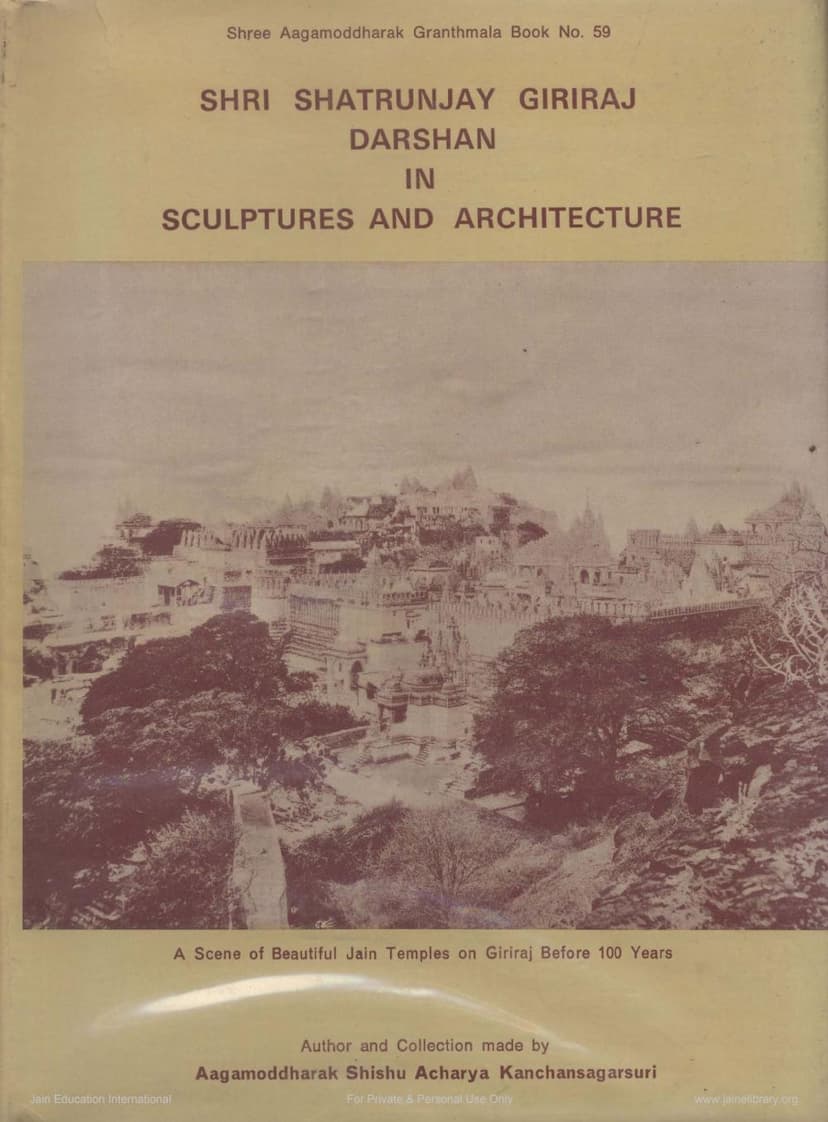Shatrunjay Giriraj Darshan In Sculptures And Architecture
Added to library: September 2, 2025

Summary
Here's a comprehensive summary of the provided Jain text, "Shatrunjay Giriraj Darshan in Sculptures and Architecture," based on the provided pages:
Overall Purpose and Content:
This book, authored and compiled by Acharya Kanchansagar, offers a visual and descriptive exploration of the Jain pilgrimage site of Shatrunjay, also known as Giriraj or Siddhachala. It aims to provide readers with a "darshan" (vision or glimpse) of Shatrunjay through its sculptures and architecture, detailing its religious significance, historical renovations, pilgrimage practices, artistic marvels, and epigraphic records. The English edition is a translation and enrichment of a previous Gujarati publication.
Key Themes and Sections:
-
Religious Significance and Sanctity:
- Shatrunjay is described as one of the most sacred Jain pilgrimage sites, revered for the attainment of moksha (liberation) by numerous Tirthankaras, saints, and devotees throughout history.
- It's highlighted that mere pilgrimage to Shatrunjay, even with minimal observance, yields immense punya (merit), far surpassing offerings or austerities at other holy places.
- The text emphasizes the spiritual potency of the hill, which aids in the liberation of the jivatma (soul).
-
Historical Context and Literature:
- The book acknowledges various ancient texts and authors who have documented Shatrunjay, including Shatrunjaya Mahatmya by Dhaneshwarasuri.
- It references earlier works and scholarly research on Shatrunjay by figures like James Burgess, Henry Cousens, and G. Buhler, placing this publication within a broader academic and devotional tradition.
- The text traces the historical renovations of the temples on Shatrunjay from ancient times up to the modern period, attributing them to various kings, merchants, and devoted individuals.
-
Architectural and Sculptural Grandeur:
- A significant portion of the book is dedicated to describing the numerous temples (toonk) that adorn the Shatrunjay hill.
- It details the artistic styles, intricate carvings, architectural features like shikharas (domes), balconies, pillars, and the decorative elements of various temples.
- Specific temples and their unique features are mentioned, such as Dada's temple, Kumarpal Maharaja temple, Chaumukhji temple, and temples dedicated to various Tirthankaras.
- The book includes numerous photographs illustrating the architectural splendor and sculptural details, making the "darshan" aspect tangible for the reader.
-
Pilgrimage (Yatra) and Rituals:
- The book outlines the phases of a pilgrimage to Shatrunjay, describing the ascent through various stages, pol (gates), and significant locations like Pagla-Deri (footprint shrines) and Suryakund.
- It details various Jain rituals and observances performed on Shatrunjay, including Khamasanas, Pradaxinas, Chhattha, Attham, and specific dates of importance.
- The tradition of Patta Juharwa (worshipping painted scrolls) as a substitute for physical pilgrimage is also mentioned.
- The importance of observing Chaturmas (four-month monsoon retreat) in Palitana, with specific rules regarding touching the hill, is explained.
-
Epigraphic Records (Inscriptions):
- A crucial part of the publication is the inclusion of numerous inscriptions (lekha) found on idols, temples, and stone slabs within Shatrunjay.
- These inscriptions, primarily in Devanagari characters, provide historical data on the establishment and renovation of temples, the names of patrons, their lineage, the dates of installation, and the gurus who consecrated them.
- The book includes detailed transliterations and notes on these inscriptions, highlighting their value for historical and archaeological research.
-
Author's Dedication and Motivation:
- Acharya Kanchansagar dedicates the book to his Guru, Aagamoddharak Acharya Maharaj Shri Anandsagarsuriswarji, acknowledging his profound influence and guidance.
- The author expresses his inspiration from earlier works and the desire to share the grandeur of Shatrunjay with a wider, English-speaking audience.
- The publisher notes the effort involved in translating and enriching the Gujarati text with photographs and inscriptions, aiming to make it accessible and appealing to modern readers.
Key Figures Mentioned:
- Acharya Kanchansagar: The author and compiler.
- Acharya Anandsagar Surishwarji: The author's revered Guru.
- Tirthankaras: Rishabhadev (Aadishwar), Mahavir Swami, Neminath, and others are mentioned in connection with Shatrunjay's history.
- Historical figures: Bharat Chakravarti, Pundarik Ganadhar, King Bharat, King Dandavirya, Ishan Indra, Mahendra, Brahmendra, Chamarendra, Sagar Chakravarti, Vyantarendra, Chandrayasha, Chakradhar, Ramachandra, Pandavas, Javadsha, Bahad Mantri, Samarasah, Karmasha, Vastupal, Tejpal, and Sheth Shantidas are frequently cited for their roles in renovations or temple constructions.
- Scholars and Authors: James Burgess, Henry Cousens, G. Buhler, Dhaneshwarasuri, Pandit Virvijay, and others are mentioned for their contributions to the study of Shatrunjay.
Publisher's Role and Support:
The Aagamoddharak Granthamala published the book as part of its series. The publication involved collaboration with printers, proofreaders, and photographers, with a commitment to preserving and disseminating Jain knowledge.
Overall Impact:
"Shatrunjay Giriraj Darshan in Sculptures and Architecture" serves as a valuable resource for understanding the multifaceted significance of Shatrunjay. It combines religious devotion with historical and artistic appreciation, providing a comprehensive guide for pilgrims, scholars, and anyone interested in Jain heritage. The extensive collection of photographs and inscriptions makes it a visually rich and historically significant document.